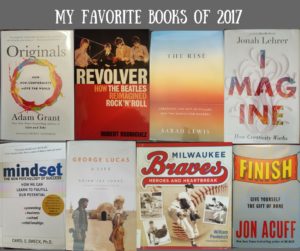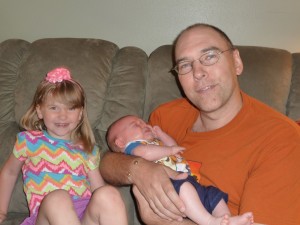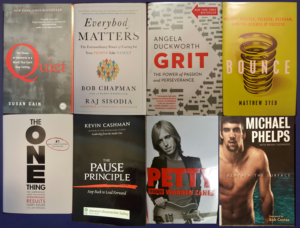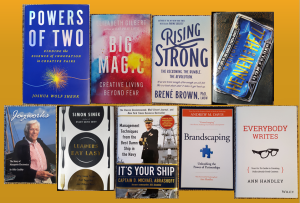 I found myself in the company of some wonderful books in 2017. Some I had previous experience with the authors’ work and was interested in reading something new, others were recommendations, one was a gift, while others I discovered on my own. No matter how these books found their way into my life, I’m glad they did. I’m a better person for having read them.
I found myself in the company of some wonderful books in 2017. Some I had previous experience with the authors’ work and was interested in reading something new, others were recommendations, one was a gift, while others I discovered on my own. No matter how these books found their way into my life, I’m glad they did. I’m a better person for having read them.
My Favorite Books of 2017
My Favorite Books of 2016
Books seem to find their way into my hands at exactly the right time. This year’s selections are a perfect example of that. It’s also fascinating how one book leads to others and how, after looking back at the books I read in 2016, a theme emerges. The eight books on this list had an impact on me and I hope you get a chance to read them, if you haven’t already. Here are my favorite books of 2016:
Quiet: The Power of Introverts in a World That Can’t Stop Talking by Susan Cain – I purchased this book a few years ago and only got around to reading it this year. If I had known it was this good I would have read it immediately. This is a powerful book. Often, it’s not the loudest voice in the room we should be listening to, but the quiet ones. As a society, we need to place more value in the thoughts and ideas of introverts and work forces should understand how to draw out those responses without putting an introvert on the spot, which s exactly what they don’t want.
I originally got it to learn more about me. I’ve taking personality assessments where I’ve been shown to be a strong introvert, though I took one recently and am now a weak extrovert. I think that’s because I’ve adapted to work environments where before I worked in a team, I’m now more independent. What I didn’t expect, is that halfway through reading it I realized I was learning a lot about both of my parents. I had never considered my dad an introvert, but reading Quiet, made me see him in a new light.
Cain explores how extroverts came to be the ideal that someone should achieve and the role introverts play in society today. She gives many examples of quiet leadership and points to one example of how Warren Buffet prospered during the recession, while Wall Street failed. Cain also lays out of great tips on when to be an extrovert and how introverts can approach work, and how work places should accommodate for introverts in their work force. Those that follow Cain’s guidance will flourish. Highly recommended for introverts or anyone who knows one.
Everybody Matters: The Extraordinary Power of Caring for Your People Like Family by Bob Chapman and Raj Sisodia – Chapman is the CEO of Barry-Wehmiller, a leader in the packaging, paper, and consulting industries. This book is the blue print for how companies can treat employees with humanity and respect and, coincidentally, become more profitable in the process. From the forward, written by Simon Sinek, you know it’s going to be good. Sinek has used Chapman’s company as an example of how to run a company the right way; with caring and compassion for others.
Chapman wasn’t always that kind of leader and Barry-Wehmiller wasn’t always that kind of company; a company that placed people over profit. It took a commitment to lead in a different direction and stick with it. In the end, the company culture changed. Employees were involved in decision making. Mistakes were seen as a learning experience. The company became more caring. Time clocks were gone, locks were removed from supply rooms, everyone entered through the same door to go to and leave work. And, boy did the employees respond, even the so called “bad eggs.” The so called trouble employees became the strongest proponents of the new culture, when they realized it wasn’t just talk, but it was real.
The BW Leadership Institute, was born out of a continual need for education. Chapman is not just talking about making people cared for as employees, but cared for as people. Their lives are transformed. I read story after story about people changing in every aspect of their lives with improved marriages, stronger family relationships, and becoming better parents. If you only read a few books from this list, make sure this is one of them.
Grit: The Power of Passion and Perseverance by Angela Duckworth – I grew up believing that successful people where those who showed extraordinary talent and genius, then took advantage of or exploited their gift. In fact, what Duckworth’s research has shown is that talent is only part of the equation. Talent matters, but not as much as we think. It’s effort that makes the difference in whether we succeed. It’s those people that don’t give up when others do that pushes them into another realm.
Duckworth studied grit in everyone from spelling bee champs to world-class athletes to West Point cadets and has developed a grit formula. It is this – talent x effort = skill and skill x effort = success. Successful people do difficult work and spend time in deliberate practice. This contradicts the 10,000 hour rule, a little bit. It’s not that you spend hours practicing but how you spend those hours to improve your skills. One other thing to help improve your skills is to compete with those that are slightly better than you. They will up your game and you’ll improve because of it.
I wish this book had been written 30 years ago. Reading it, I reflected on my upbringing and the role talent versus grit played in my life. I was always on the talent/genius side of things. That talent and genius would be recognize and rewarded. In fact, what I’ve realized in my life, which Duckworth’s book shines a light on so brightly, is that grit is the only attribute that allows you to achieve the things in life that make you feel fulfilled. Grit is a definite must read.
Bounce: Mozart, Federer, Picasso, Beckham and the Science of Success by Matthew Syed – Syed’s book came out a few years before Duckworth’s Grit and it falls into the same space, but Syed comes at success with a whole different perspective. He ‘s a three-time Commonwealth table tennis champion, and two-time Olympian. He draws on his own personal experience and looks at many other successful people to find out how they became so successful.
As one would guess, there are many examples of athletes used in the book, making it easy to relate to, but he also examines grand master chess players, composers, artists and students. He’s researched how they were raised, coached, and tutored. He goes back into the lives of successful people, but also looks at the science behind success. The conclusion is, success is all about mindset.
This mindset emphasizes hard work over talent. Like Duckworth, Syed has discovered that those who work the hardest at deliberate practice become the most skilled at their endeavor and end up being successful as a result. Talent again, is thrown out the window. It’s not the talented that become the dominate player in certain sports or fields of work, but it’s those who devote the most devoted hard work to their craft. Bounce is a remarkable book.
The One Thing: The Surprisingly Simple Truth Behind Extraordinary Results by Gary Keller with Jay Papasan – I found this book at the airport in Las Vegas. Better time management was one of my goals for 2016. This book was critically helpful in achieving my goal. This book is Pareto’s Principle, or the 80/20 rule, on steroids. Instead of breaking down tasks into smaller ones to cross off of a list, this book shows how to concentrate on only one thing at a time. We are often overwhelmed at work, and life in general, with too many distractions. This leads to watered down results, depleting energy and lack of focus.
One phrase from the book stood out for me is this, “What’s the one thing I can do, such that by doing it, everything else will be easier or unnecessary?” It’s a focus on big picture thinking. Start there, start big. That’s the one thing you should work on to start your day. Then when that’s done, you’ll work on the next one thing. Keller argues that starting with the big thing will let the small things either fall into place or become unnecessary to do.
If you’re like me you start your day knocking off a couple of small tasks so you can cross things off your list, which makes you feel like you’re being productive. But, this only keeps you working on small goals, which lead to small and insignificant results. Multi-tasking and juggling work are myths that we need to forget if we want to achieve great things. The One Thing had an immediate impact on my work at a time when I could have easily been overwhelmed. Instead I used this book to guide me to a highly productive part of my year, which lead to great personal satisfaction and success for my organization. It is a breeze to read and the lessons can be easily applied to your life.
The Pause Principle: Step Back to Lead Forward by Kevin Cashman – I tend to take my time when making decisions and thought it was a weakness. Cashman shows that pausing to think things over before making decisions is a strength. Organization’s seek immediate answers to problems, but this could lead to dysfunctional momentum; moving forward in a direction that’s not best for the future of the organization. When we pause to think about problems allows new ideas to emerge and creativity to flourish. Moving too quickly to the “right” answer kills collaboration and innovation.
Organizations that adopt the Seven Pause Practices discussed are more innovative and, in the end, more profitable. These practices will change the culture of the organization and allow employees to grow. The Pause Principle gets at some very fundamental questions about core values of an organization. Without pausing, an organization can lose focus on why it exists. This book is for anyone who want results fast and problems solved yesterday. Read this book, try a new approach to decision making and you’ll be presently surprised at how much more effective you’ll become.
Tom Petty: A Biography by Warren Zanes – I’m a huge Tom Petty fan and thought I knew all there was to know about the man and his music. Boy, was I wrong. Zanes tells a masterful story, in part because he was given access to people in Petty’s inner circle that no one has had access to before, which allowed him to paint a complete picture of Petty like we’ve never seen before. Zanes is able to give the stories context and offer a rich account of Tom Petty’s life.
Like a lot of people who didn’t have a positive family environment to grow up in, Petty found an escape in music. Music became his world and his life’s goal was to be in a really good band and keep it together. It wasn’t easy, even after landing a record deal. Turmoil was a constant in his personal life and within the band. Every day was a fight to survive and when he cleared one hurdle another one hit him right in the face. Whether it was declaring bankruptcy, fighting with his record label, someone burning down his house, trying to keep his band together, or trying to leave a failing marriage, work was the one thing he could count on to pull him through. He wrote, recorded and toured non-stop. There was never time to take a break and appreciate his success and sadly, he doesn’t seem to have been very happy along the way. Petty’s unhappiness led to substance abuse and addiction. It’s an all too familiar rock and roll story, but his has a happy ending.
Achieving success is never an individual effort, and he had people show up at just the right time in his life to take him to the next level. I enjoyed taking a peek inside his relationships with Leon Russell, Denny Cordell, Jimmy Iovine, Dave Stewart, Jeff Lynne George Harrison and Rick Rubin. Tom Petty and the Heartbreakers are now in their 40th year, which is remarkable. Most importantly, he got through life with all it’s ups and downs and is finally at peace. Petty’s story is another reminder that success doesn’t make life any easier to live.
Beneath the Surface by Michael Phelps with Brian Cazeneuve – During the 2016 Olympic games in Rio I became enamored with Michael Phelps. I was watching at history being made and wondered how the best athlete the Olympics has ever seen came to be. I read something about how he practiced on Sundays when other swimmers rested that day and how that would give him and extra 52 practices a year over his competition. When I read that I had to learn more.
You’d never know it but Michael Phelps didn’t like swimming as a kid and he was afraid to get his face wet! Funny, how life turns out. This book is a great lesson in taking the talent you have and nurturing it and practicing to improve your skills. Phelps was fortunate enough to have a coach that pushed him to be the best swimmer he could. I couldn’t help think this was also a book about Bob Bowman, his coach. I don’t want to get too melodramatic, but without his coach, I doubt we’d have heard of Michael Phelps. The difference between winning a gold medal or no medal at all is sometimes hundredths of a second. That’s when you realize the practice put in makes all the difference. The drive to compete is in most of us, but the extra push from a coach at the right moment, can help give you the slight edge you need.
I didn’t know much about Michael Phelps before reading this book. This book was published in 2008, so it’s a great look into the life of someone before he became one of the greatest athletes to every grace our planet. He’s likable, honest, and humble, which I hope still defines him. I couldn’t help but feel happy for his success, knowing what’s happened since he wrote it. It would be interesting to know if his approach to training and preparation has changed since this was written.
Did any of these make it onto your list for 2016? What were some of your favorites? Here’s looking forward to another year of books that enlighten, educate, and entertain. Happy reading in 2017!
My Favorite Books of 2015
Another year has come and gone, but not before I read my way through some inspiring and thought-proving books. Did these books top 2014’s list? I don’t know, but they’re just as awesome. I delved into creativity, a biography, leadership, and marketing. I took away a lot reading these, and I’m positive you will too. Without further ado, here are my favorite books of 2015.
How To Remain Calm When Your Toaster (Or Anything Else) Is On Fire
My work colleague bumped into another person at work when she was leaving the office we share and screamed when they collided. When my colleague came back she mentioned how when things startle her it makes her feel better to make a loud noise. She then reminded me of the story I told her about the fire extinguisher.
7 Steps to Become a Learning Machine
 In my last post I wrote about finding the motivation to learn something new. Once you have the motivation, how do you do actually go about learning?
In my last post I wrote about finding the motivation to learn something new. Once you have the motivation, how do you do actually go about learning?Learning Something New
 When I was 10 years old my sister and I went with my mom to visit one my mom’s childhood friends in Jackson, Mississippi. My mom’s friend had kids around our age and every afternoon we’d head to the local swimming pool. At first I didn’t want to go because I didn’t know how to swim. Being in the water was terrifying. I thought I might go under and drown.
When I was 10 years old my sister and I went with my mom to visit one my mom’s childhood friends in Jackson, Mississippi. My mom’s friend had kids around our age and every afternoon we’d head to the local swimming pool. At first I didn’t want to go because I didn’t know how to swim. Being in the water was terrifying. I thought I might go under and drown.
It Pays to Ask
Last year I won tickets to go to INBOUND in Boston. In the marketing world, it’s a big deal. The conference boasts an amazing lineup of incredible speakers, authors, and experts. Unfortunately, I couldn’t work out my schedule with my employer and wasn’t able to attend. As the conference approached, I looked at going this time around.
Do It Today. Do It Now.
 Over the weekend, I made a quick trip up to Sparta to meet my 6-week-old nephew. I wanted to be able to see him while he was still a baby, plus it’s been a while since I’d seen my niece, sister, brother-in-law, and my parents. But, I had a limited amount of time that worked in my schedule. I had a day to visit since I had some other things I needed to do in Milwaukee.
Over the weekend, I made a quick trip up to Sparta to meet my 6-week-old nephew. I wanted to be able to see him while he was still a baby, plus it’s been a while since I’d seen my niece, sister, brother-in-law, and my parents. But, I had a limited amount of time that worked in my schedule. I had a day to visit since I had some other things I needed to do in Milwaukee.
What I Did at WordCamp Milwaukee 2014
 WordCamp – the name conjures up an idyllic scene in the deep woods fighting off mosquitoes, making smores, and discussing the attributes and origins of words. Although Idyllic (in beautiful downtown Milwaukee), WordCamp is an event where people gather to learn about WordPress, the open source platform that 20% of the world’s websites run on.
WordCamp – the name conjures up an idyllic scene in the deep woods fighting off mosquitoes, making smores, and discussing the attributes and origins of words. Although Idyllic (in beautiful downtown Milwaukee), WordCamp is an event where people gather to learn about WordPress, the open source platform that 20% of the world’s websites run on.




Follow Me!